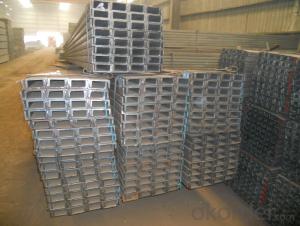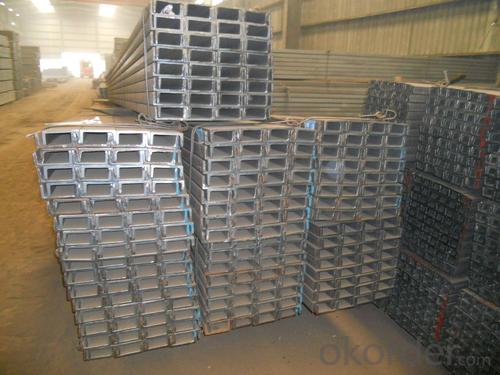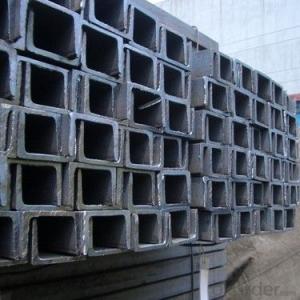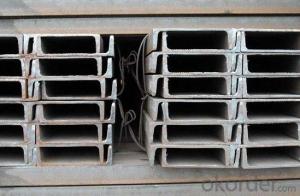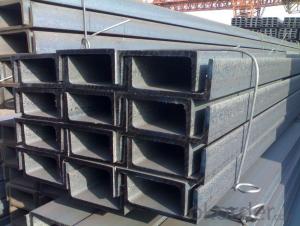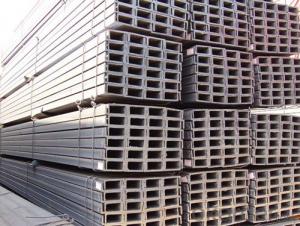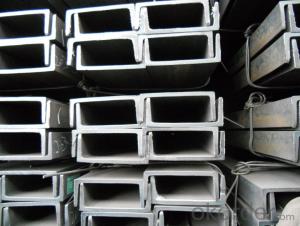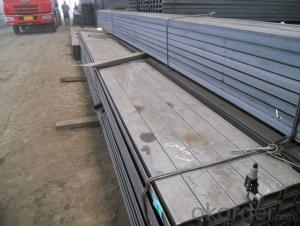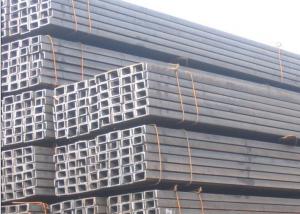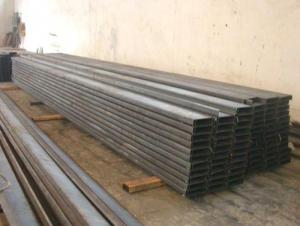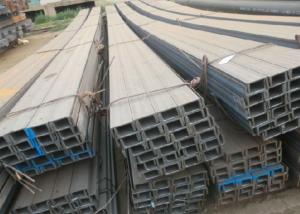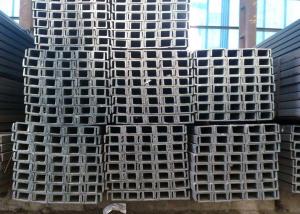High Quality Steel Channel
- Loading Port:
- China Main Port
- Payment Terms:
- TT OR LC
- Min Order Qty:
- -
- Supply Capability:
- -
OKorder Service Pledge
OKorder Financial Service
You Might Also Like
Specifications of JIS Channel Steel:
1. We are definitely speciallizing in manufacturing and supplying channel steel as per japanese standard, which is characterised with high mechanical strength and competitive prices.
| Standard | JIS G3192 |
| Material Grade | SS400 |
| Sizes | 50mm to 200mm |
| Sales Volume/Year | 3000MT |
| Destination Area | Middle East, Africa, Southeast Asia |
Size and Mass:
| Size (mm) | Mass (Kg/m) | Size (mm) | Mass (Kg/m) |
| 50*25*3.0 | 2.37 | 75*40*4.5 | 5.85 |
| 75*40*3.8 | 5.30 | 75*40*5.0 | 6.92 |
| 75*40*4.0 | 5.60 | | |
The mechanical property of JIS Channel Steel:
Grade | Yield Strength,N/mm² | Extension Strength N/mm² | |||
Thickness of Steel,mm | |||||
≦16 | >16-≦40 | >40-≦100 | >100 | ||
SS400 | ≧245 | ≧235 | ≧215 | ≧205 | 400-510 |
Package & Delivery of JIS Channel Steel:
1.The channel steel will be packed in bundle with steel wire at each end of every bundle and color marking in order to help the customer to recognize his goods more easily at sight.
2. And the channel steel could be loaded into 20ft or 40ft container, or by bulk cargo.If the weight of each bundle reaches more than 3.5 mt, the loading by break bulk cargo should be choosed.When the weight of each bundle reaches less than 3mt, the loading by container should be choosed.
3.As for the transportaion from mill to loading port, the truck will be usually used. And the maximum quantity for each truck is 40mt.
4.All in all, we could do in accordance with customer's request.
*If you would like to get our price, please inform us the size, standard/material and quantity. Thank you very much for your attention.
- Q: Can steel channels be used in commercial construction?
- Yes, steel channels can be used in commercial construction. Steel channels provide structural support and are commonly used in framing systems, roof trusses, and as structural elements in walls and floors. They are versatile, durable, and offer excellent load-bearing capabilities, making them suitable for various commercial building applications.
- Q: Can steel channels be used for architectural purposes?
- Yes, steel channels can be used for architectural purposes. Steel channels are versatile and can be utilized in many architectural applications such as the construction of building frames, support structures, and architectural facades. They provide strength and stability to the overall structure, making them ideal for architectural projects where durability and load-bearing capacity are important considerations. Steel channels also offer flexibility in design as they can be easily fabricated and customized to meet specific architectural requirements. Moreover, their sleek and modern appearance can enhance the aesthetic appeal of a building, making them a popular choice among architects and designers. Overall, steel channels are a reliable and practical option for architectural purposes.
- Q: How do steel channels perform in terms of earthquake resistance?
- Steel channels perform well in terms of earthquake resistance due to their high strength and ductility. The structural properties of steel, such as its ability to flex and absorb energy, make steel channels highly resistant to seismic forces. Additionally, steel channels can be designed and reinforced to withstand the dynamic loads and ground motions experienced during an earthquake, making them a reliable choice for seismic-resistant construction.
- Q: Standard for channel 20
- Can check the hot-rolled ordinary channel GB707-88
- Q: Can steel channels be used for framing door and window openings?
- Yes, steel channels can be used for framing door and window openings. Steel channels are commonly used in construction for structural support and framing purposes. They are known for their strength and durability, making them suitable for framing openings. Steel channels provide a sturdy framework that can support the weight of the doors and windows without flexing or warping. Additionally, steel channels offer excellent resistance to corrosion and can withstand extreme weather conditions, making them a reliable choice for framing door and window openings in both residential and commercial buildings.
- Q: How do you calculate the weight of 100 channel steel?
- CAD drawing can also be used to calculate the cross-sectional area of 100 channel, or other ways to first calculate the cross section area of 100 channel.
- Q: How about the moment of inertia of two back to back channels? There is no formula,,,,.
- 1, all kinds of channel section of the moment of inertia can be found in the materials manual. Usually two values of two axes through a centroid. In the two back to back cross section, the X axis of the cross center (with the upper and lower flange parallel axes) is added as long as the value is added. On the common boundary to convert back to back, not for any centroid axis of inertia moment = the centroid moment of inertia |+ cross-sectional area X centroid to the shaft of the vertical distance square. 2, if you have AutoCAD software, you can directly find any section of the inertial moments of graphics. 3, it is suggested that the textbook of mechanics of materials be turned over again. This is the basic skill.
- Q: Are steel channels suitable for cold storage facilities?
- Steel channels are indeed a suitable option for cold storage facilities. Renowned for their robustness and endurance, steel channels excel at bearing heavy loads and enduring severe temperatures. Cold storage facilities necessitate materials capable of enduring frigid temperatures without jeopardizing their structural integrity, and steel channels fulfill these demands effortlessly. Furthermore, steel channels exhibit resistance to corrosion, a vital attribute in cold storage facilities where dampness and condensation may be prevalent. In summary, steel channels provide the imperative strength, durability, and corrosion resistance required for an optimal selection in cold storage facilities.
- Q: What are the different types of steel channel sections?
- There are several different types of steel channel sections, including C channels, U channels, and Z channels. C channels have a C-shaped cross-section and are commonly used for structural applications such as framing and supports. U channels have a U-shaped cross-section and are often used as edging or trim on metal sheets or as structural components in construction. Z channels have a Z-shaped cross-section and are typically used for framing and support applications where additional strength is required.
- Q: What are the different types of bending for steel channels?
- The different types of bending for steel channels include cold bending, hot bending, and press brake bending.
Send your message to us
High Quality Steel Channel
- Loading Port:
- China Main Port
- Payment Terms:
- TT OR LC
- Min Order Qty:
- -
- Supply Capability:
- -
OKorder Service Pledge
OKorder Financial Service
Similar products
Hot products
Hot Searches
Related keywords
